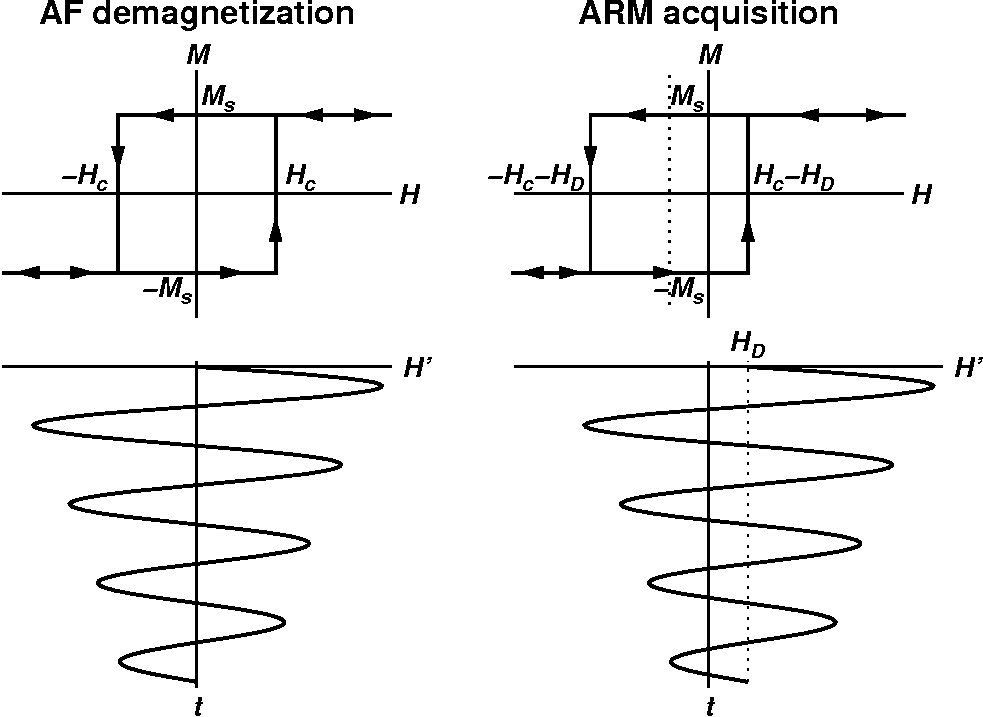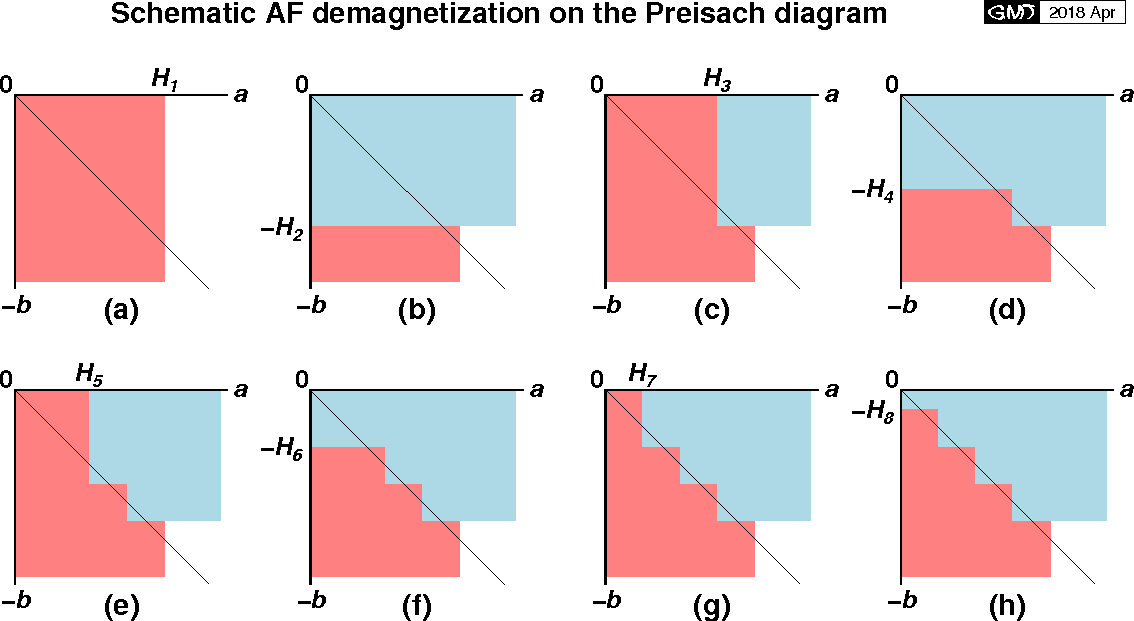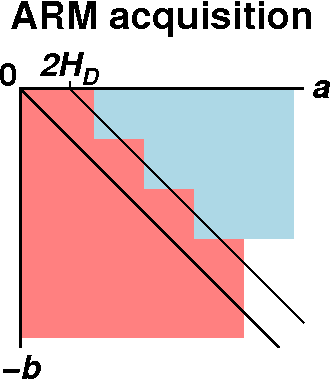Anhysteretic remanent magnetization of single-domain grains: Preisach diagram
Alternating field demagnetization and anhysteretic remanent magnetization
Consider a mass of SD grains whose easy axes are in the same direction and suppose that there is a certain distribution in the coercive force \(H_c\). Now AC magnetic field is applied along the easy axis and its amplitude is gradually decreased (left-hand figure, below). Suppose that first to third peak fields are \(H\), \(-(H-\delta)\), and \((H-2\delta)\). In the course of the first one and half cycle, magnetizations with \((H-\delta)\) < \(H_c\) ≤ \(H\) are blocked to \(M_s\) while those with \((H-2\delta)\) < \(H_c\) ≤ \((H-\delta)\) are blocked to \(-M_s\). Magnetizations with \(H_c\) > \(H\) are not affected by the AC field. By the time the AC field reaches to zero, magnetizations of \(M_s\) and \(-M_s\) cancel out. This is the alternating field (AF) demagnetization in which remanence components whose coercive force is less than \(H\) are demagnetized. In the stepwise AF demagnetization, this procedure is repeated with successively larger peak field, demagnetizing the remanence components with successively larger \(H_c\).

AF demagnetization should be carried out in a space magnetically shielded from static fields. The reason is that if a DC field \(H_D\) is superposed on the AC field \(H\), a remanence will be created along \(H_D\). This remanence is called an anhysteretic remanent magnetization (ARM). Right-hand figure above shows a hysteresis curve and AC field with a bias of positive DC field \(H_D\) (parallel to \(H\)). In the figure, \(H\) and \(H'\) are the applied field (such as a field given from a power supply) and the actual field (including the DC bias field) put on the SD grains, respectively. For a positive \(H_D\) the hysteresis curve shifts to left by \(H_D\), and hence all magnetizations with \(H_c\) ≤ \(H+H_D\) are rotated to \(+M_s\) and remains there as blocked. Magnetizations with \(H_c\) ≤ \(H-H_D\) are rotated to \(-M_s\) but never remain there. Those with \(H_c\) > \(H+H_D\) are not affected by the AC field. This is the process of ARM acquisition. Obviously ARM intensity is larger when acquired under the larger AF field because more magnetizations with larger \(H_c\) are rotated along the \(H_D\) direction. However, ARM intensity is independent of the magnitude of \(H_D\); no matter how small \(H_D\) may be, magnetization is saturated to the \(H_D\) direction. This is in conflict with the fact that ARM intensity is proportional to a small DC field such as a geomagnetic field. In fact, ARM is often used in various scenes of paleomagnetic experiments as a remanence which has characteristics similar to TRM.
ARM acquisition model by the Preisach diagram
The problem of ARM intensity is overcome by introducing the Preisach diagram which was developed by Ferenc Preisach in 1930's. The following introduction to the Preisach diagram is based on Nagata & Akimoto (1961). In the theory, it is supposed that an interaction field \(H_i\) of various magnitude acts among the SD grains. The hysteresis curve shifts to left for a positive \(H_i\) which is parallel to \(H\) (figure (a) below) and to right for a negative \(H_i\) antiparallel to \(H\) (figure (c)). Critical fields which rotate the magnetization to \(M_s\) and \(-M_s\) are denoted \(a\) and \(-b\), respectively. It is supposed that SD grains have various combinations of \((a,-b)\) which corresponds to a point on the fourth quadrant of \(a\)-\(b\) plane (figure (b)). The area of \(a\)-\(b\) plane are divided by a line \(a=-b\); left-lower and right-upper sides correspond to the left and right shifted hysteresis curves, respectively.

Application of a magnetic field causes the magnetization of each grain to either rotate to the field direction or to stay at the original position. The magnetization process is governed by the rules; (1) a positive field \(H\) causes all the negatively magnetized grains with \(a\) ≤ \(H\) to rotate to \(+M_s\), and (2) a negative field \(-H\) causes all the positively magnetized grains with \(b\) ≤ \(H\) to rotate to \(-M_s\).


Figure above shows a series of Preisach diagrams of imaginary AF demagnetization in which gradually decreasing fields with alternate signs are applied as, \(H_1\), \(-H_2\), \(\cdots\), \(H_7\), \(-H_8\). Red and blue areas indicate grains of positive and negative magnetizations, respectively. It is supposed that magnetizations on the blank area are in random signs and cancel out. The last Preisach diagram (h) after application of \(-H_8\) shows that the sizes of red and blue areas are equal, i.e. zero total remanence, after the end of AF demagnetization.
In ARM acquisition under a DC field \(H_D\), decreasing fields with alternate signs are applied as, \(H_1+H_D\), \(-H_2+H_D\), \(\cdots\), \(H_7+H_D\). Figure in the right is the Preisach diagram after application of the last field \(H_7+H_D\). It is seen that the area of positive magnetization is larger than that of negative magnetization, i.e. a positive ARM is acquired. The striped area between the two lines of \(a=-b\) and \(a=-b+2H_D\) corresponds to the magnitude of ARM. Hence, this ARM model which introduces interaction fields on the Preisach diagram explains the dependency of ARM not only on the peak field of the AC field but also on the weak DC field.
It is essential for this ARM model to suppose the existence of interaction fields of various magnitudes. In the next page it will be shown that another ARM model, incorporating Neel's thermal activation theory, explains the above two features of field dependency of ARM for noninteracting SD grains.
References:
- Nagata, T., and S. Akimoto, Chapter 8: Other physical processes leading to remanent magnetization, in, Nagata, T., Rock Magnetism (Revised Edition), 350 pp., Maruzen, Tokyo, 1961.